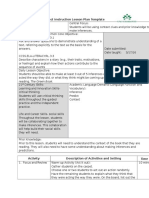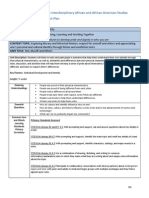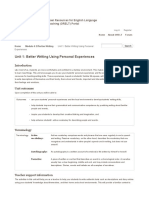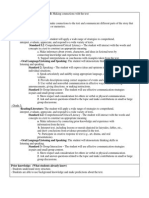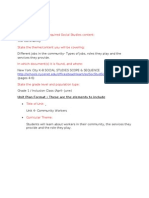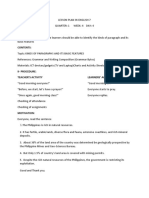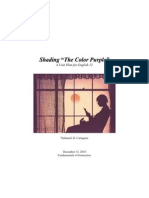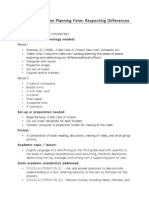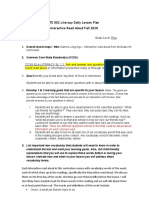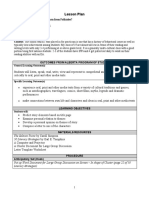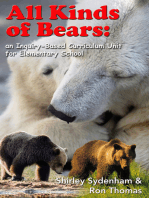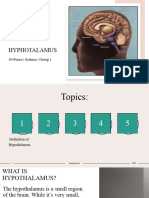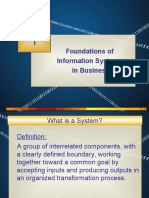Unit 1: People and Animals
Unit 1: People and Animals
Uploaded by
Mario Javier Hernandez BallinCopyright:
Available Formats
Unit 1: People and Animals
Unit 1: People and Animals
Uploaded by
Mario Javier Hernandez BallinOriginal Title
Copyright
Available Formats
Share this document
Did you find this document useful?
Is this content inappropriate?
Copyright:
Available Formats
Unit 1: People and Animals
Unit 1: People and Animals
Uploaded by
Mario Javier Hernandez BallinCopyright:
Available Formats
First Bimonthly
page 10
Unit 1
page 12
page 13
People
and Animals
Unit Purpose:
The purpose of this unit is to enable you to describe people and animals by making reference to their
physical appearance, (in)abilities and habits/routines.
Social Practice:
Giving and obtaining factual information of a personal and non-personal kind.
Unit functions:
1.1. Expressing (in)ability in the present.
1.2. Describing people and animals.
Performance evidence
You will be able to recognize and understand quotidian texts in order to use
them purposefully.
You will be able to recognize and understand academic texts in order to compare
with the rest of the class their own interpretation and judgment of such texts.
You will be able to recognize and understand short literary texts in order to com-
ment on the feelings generated by them.
You will be able to use language creatively and appropriately by selecting lexis,
phrases and grammatical resources in order to produce short, relevant texts
regarding peoples and/or animals (in)abilities, physical characteristics, and
habits/routines.
INGLES P 1ok.indd 12-13 8/8/08 16:36:18
Connections 2 pl1 1-20.indd 10 28/8/08 17:12:02
page 11
Unit 1
page 12
page 13
People
and Animals
Unit Purpose:
The purpose of this unit is to enable you to describe people and animals by making reference to their
physical appearance, (in)abilities and habits/routines.
Social Practice:
Giving and obtaining factual information of a personal and non-personal kind.
Unit functions:
1.1. Expressing (in)ability in the present.
1.2. Describing people and animals.
Performance evidence
You will be able to recognize and understand quotidian texts in order to use
them purposefully.
You will be able to recognize and understand academic texts in order to compare
with the rest of the class their own interpretation and judgment of such texts.
You will be able to recognize and understand short literary texts in order to com-
ment on the feelings generated by them.
You will be able to use language creatively and appropriately by selecting lexis,
phrases and grammatical resources in order to produce short, relevant texts
regarding peoples and/or animals (in)abilities, physical characteristics, and
habits/routines.
INGLES P 1ok.indd 12-13 8/8/08 16:36:18
Connections 2 pl1 1-20.indd 11 28/8/08 17:12:02
Unit 1
Unit one
Sugerencias
didcticas
1. Esta actividad se puede extender si se pide a los alumnos
y las alumnas que elaboren una tarjeta de informacin so-
bre algn miembro de su familia o de ellos mismos. Lue-
go, en parejas, pueden hacer preguntas y contestar sobre
la informacin que obtuvieron..
1. This activity can be extended by having the students create
an information card about a family member or about
themselves and then in pairs ask and answer.
Meeting New People
In this lesson you will: Learn the symbols in your book. Review how to ask for and give personal information.
Review how to express likes and dislikes.
z
e
r
o
,. Getting information about people. Learn about the people in the ID cards. Work in pairs. Student A, go
to page 166, activity A, and Student B, go to page 171, activity A.
L
e
s
s
o
n
Unit 1, People and Animals page 14
). Learn about your book. Match the symbols with the words.
). Act out
,. Check
. Match
. Underline
;. Listen
6. Complete
!. Point at
. Work in pairs
u. Write
)0. Read
)). Work in groups
),. Look
). Use your notebook
z`
}`
c`
,`
i`
`
|`
)`
]`
|`
y`
j`
m`
Social practices: Giving and obtaining factual information of a personal and non-personal kind.
INGLES P 1ok.indd 14 29/7/08 17:03:59
1
page 1
Connections 2 pl1 1-20.indd 12 28/8/08 17:12:05
page 13 Unit 1
1. Sugirales que escriban en sus cuadernos un texto similar
al de la actividad 4 con sus datos y los de un hermano o
hermana.
. Comente a los estudiantes que en el recuadro Discover the
rule se presentarn actividades con las cuales aprendern
algunas reglas de la lengua inglesa.
1. Suggest to the students to write in their notebooks a text
similar to the one in exercise 4 with their data and that of
a brother or a sister.
. Comment to the students that in the Discover the rule
box there are activities in which they will learn some of the
rules of the English language.
!. Work in groups of three. Interview your partners
and complete the other two columns.
Do you like sports? No, I dont. I hate them.
Do you like music? Yes, I love it.
,..
You Partner A Partner B
). School
j]|,
,. Music
. Parties
. Friends
;. Sports
6. TV
Meeting New People
. Going back to school. Listen to Ricky and Ana talking to their mother and complete the sentences
with the best option.
). Ricky and Ana get up at _____. . Ricky _____ Mr. Morgan.
z` 6:00 }` 6:45 c` 7:00 z` doesnt like }` hates c` likes
,. Ana _____ to have the same teachers. . Ricky and Ana usually go to the club _____.
z` wants }` doesnt want c` prefers z` by bus }` by car c` on foot.
. In your notebook, complete the paragraph about Ricky and Ana.
Ricky and Ana t)` ____________ twins. t,` ____________ are 14 years old. They t` ____________
American. They t` ____________ in New Albany, Indiana. Their address t;` ____________
25 Fresno St. Ricky and Ana t6` ____________ history, but Ana t!` ____________ Mrs. Torres class.
They t`____________ sports. Ricky (9) _________soccer and Ana t)0` ___________ tennis.
;. Work in pairs. Compare your answers with
a partner.
6. Preferences. Use your notebook. Complete the
You column below with your information.
How do you feel about the following?
page 15
z
Trzc|
,
Discover the rule
Circle the correct form of the verbs.
To express likes and dislikes we say:
I/You/We/They + like/love/hate / likes/loves/hates ...
He/She + like/love/hate / likes/loves/hates ...
I/You/We/They + dont like / doesnt like
He/She + dont like / doesnt like
Ry crticj]c Suggestion: You can start your portfolio new. A portfolio is a special place where you can keep
items and check your progress. Every time you see this icon in your book, add your work to your portfolio.
You can include your written work and projects you do in class as well as vocabulary and language from the book that
you nd interesting or difcult to remember. You can include things you nd outside of class such as songs, magazines,
articles, or things from the Internet, etc. You can also share and compare your portfolio with others in your class.
c
b c
are They are
live is
like
likes likes like
dosent like
INGLES P 1ok.indd 15 13/8/08 17:17:25
1
Connections 2 pl1 1-20.indd 13 28/8/08 17:12:07
page 14 Unit 1
Unit one
Sugerencias
didcticas
1. Solicite a los menores que lean el ttulo y los propsitos de
la leccin y anticipen lo que aprendern.
. Propngales que en parejas lean el texto de la primera
actividad en voz alta con la informacin correcta.
1. Ask the students to read the title and the goals of the lesson
and predict what they will learn.
. Suggest to the students that they read aloud in pairs the
text of the rst exercise with the correct information.
Shes very attractive
In this lesson you will learn: How to describe a persons physical characteristics.
). Listen and choose the correct option.
Peter: Whos this?
Lidia: Timmy Nicks. Shes an actress/
a rock singer.
Peter: Wow! Her hair is red/green.
Lidia: Yes, and she always wears strange
clothes/glasses.
Peter: Her hair is very short/long.
Lidia: Yes. I think shes very ugly/attractive.
Peter: Mm Im not sure.
,. Look at the chart. In your notebook, write a
similar chart with your own information.
. Work with a classmate.
Talk about your chart.
page 16 Unit 1, People and Animals
L
e
s
s
o
n
o
n
e
Trzc|
I am a
Junior High student
soccer player
My mother an
actress
My father a doctor
My brother
a police ofcer
My sister a student
}
is
Social practices: Giving and obtaining factual information of a personal and non-personal kind.
Choose the correct options.
We use a before consonants / vowels.
We use an before consonants / vowels.
Discover the rule
INGLES P 1ok.indd 16 29/7/08 17:04:06
1
Connections 2 pl1 1-20.indd 14 28/8/08 17:12:09
page 15 Unit 1
1. Sugiera a los estudiantes que elaboren una tarjeta en la
que escriban la descripcin de otro compaero o com-
paera de la clase. Invtelos a que lean la tarjeta ante el
grupo y los dems adivinen de quin se trata.
1. Students can play a guessing game by each writing on a
card a description of one of their classmates and then the
others read it and try to guess who is it.
page 17
. Look at the chart and complete the descriptions of the people in the photographs. Use
your notebook.
Shes Very Attractive
;. Work in pairs. Read your description to your
partner.
!. Work in pairs. Describe a classmate for your
partner to guess his/her name.
6. Listen and check.
He/She is
His/Her eyes are
His/Her hair is
,..
Tom is _ _ _l and t_ _ _. His hair
is _h_ _t and b_ _ _ _. His eyes
are _r_w_.
Pat is _ _ _ _t and _a_. Her eyes
are g_ _e_. Her hair is l_n_ and
c_r_y.
Sam and Jack are ________ and
________.
Their hair is ________.
Trzc|
Eye colors
green brown blue
Build
tall short
fat thin
Hair styles
curly
straight
short
long
Tom
Pat
Sam
Hair colors
blond black
brown red
See Picture Dictionary 1, on page
186, to nd vocabulary related to
colors, and Picture Dictionary 1 and
2, on pages 187, to nd vocabulary
related to physical appearance.
|, ]u|,,u|,ut
Discover the rule
Choose the correct options.
For males (boys), we use his / her.
For females (girls), we use his / her.
For more than one person, we use his / her / their.
Jack
t a l h i n
r o wn o s r
o n b u l
n r e
h o s r f t
o g
tall
thin
blond
INGLES P 2ok.indd 17 29/7/08 16:47:48
1
Connections 2 pl1 1-20.indd 15 28/8/08 17:12:14
page 16 Unit 1
Unit one
Sugerencias
didcticas
1. Solicteles que repitan las actividades de la pgina con sus
actores, deportistas o cantantes favoritos.
1. Ask the students to repeat the activities of the page using
their favorite actors, athletes or singers.
page 18 Unit 1, My First Day of Class
Photos
t
w
o
page 18
In this lesson you will learn: How to talk about someones physical characteristics and personality.
). Jack is looking at Bobbys photo album. Listen and match the names with the photographs.
,. Look at the photographs. Write the adjective under the correct photographs.
). Jackie Chan
,. Edward James Olmos
. Dido
c`
. Compare your answers with a classmate.
Salma Hayek is beautiful.
,..
). beautiful ,. ugly . handsome . old ;. young
z`
}`
|`
L
e
s
s
o
n
Trzc|
;
. Venus and Serena
Williams
Social practices: Giving and obtaining factual information of a personal and non-personal kind.
handsome
ugly
beautiful
young
old
INGLES P 2ok.indd 18 29/7/08 16:48:09
1
Connections 2 pl1 1-20.indd 16 28/8/08 17:12:17
page 17 Unit 1
1. Sugiera a los alumnos y las alumnas que busquen en re-
vistas otras personas y que externen sus opiniones sobre
ellas.
. Propngales que en parejas usen los adjetivos menciona-
dos en la leccin para describir a su familia o a sus com-
paeros o compaeras.
3. Enfatice que is se usa con las personas en singular y are se
usa con las personas en plural.
1. Students can look through magazines to nd other people
and give their opinions about them.
. Students can work in pairs and use the adjectives to
describe their family or classmates to their partner.
3. Make sure the children understand that is is used with
3rd person singular and are with 3rd person plural.
page 19
. Work with a classmate. Give your opinion about the people in the
photographs for your partner to guess his/her name.
Student A: Shakira.
Student B: I think she is beautiful and intelligent.
Student C: I think she is arrogant.
Student A: I like her very much. She is a very good singer and an excellent dancer.
,..
Student A: He is an American actor.
I think hes very handsome.
Student B: Is he Brad Pitt?
Student A: Yes.
,..
;. Jack and Bobby are looking at another photograph. Listen to their
conversation and draw a line from the adjectives to the person.
6. Work in groups. Write the names of two famous people on separate pieces of paper. Fold the papers
and make a pile. Take turns to get one paper, and give your opinion about the person on it.
). active
,. noisy
. intelligent
. lazy
}`
z`
c`
|`
,`
Photos page 19
Trzc|
6
Discover the rule
Circle the correct verbs.
She is/are active. My brother is/are lazy.
They is/are active. My brothers is/are lazy.
INGLES P 2ok.indd 19 29/7/08 16:48:25
1
3
Connections 2 pl1 1-20.indd 17 28/8/08 17:12:20
page 18 Unit 1
Unit one
Sugerencias
didcticas
1. Pdales que en parejas escriban en sus cuadernos un di-
logo como los de las actividades 1 y 2 con sus datos.
1. Ask the students to work in pairs to write in their notebooks
a dialogue like those in exercises 1 and 2 with their data.
E-mail Pen Pals
In this lesson you will learn: How to ask for and give information about physical characteristics and personality.
t
h
r
e
e
). Bobby is chatting with a new friend on the Internet. Listen and complete Bobbys description
with words from the box.
L
e
s
s
o
n
Unit 1, People and Animals page 20
,. Now read the second part of Bobbys chat and choose the correct photograph for Billy.
). black ,. brown . active . tall
Trzc|
!
Billy:
Bobby, what do you look like?
Bobby:
Im tz`________ and I have t}`________ hair.
Billy:
What color are your eyes?
Bobby:
I have tc`________ eyes.
Billy:
And what are you like?
Bobby:
Well. Im t|`________ and a bit stubborn sometimes.
Billy:
Stubborn?
Bobby:
Yes, I always want to be right.
Bobby:
Now tell me about you. What do you look like, Billy?
Billy:
Im short and a little fat.
Bobby:
What color are your eyes?
Billy:
Green.
Bobby:
And what are you like?
Billy:
I think Im kind and outgoing. I like having many friends.
Bobby:
Can you send me your picture and information?
Billy:
Certainly, yes.
Social practices: Giving and obtaining factual information of a personal and non-personal kind.
tall brown
black
active
INGLES P 2ok.indd 20 29/7/08 16:48:32
1
Connections 2 pl1 1-20.indd 18 28/8/08 17:12:26
page 19 Unit 1
1. Pregunte a los alumnos cul es la diferencia que hay entre
las preguntas que se mencionan en el recuadro. Comente
que el verbo look se usa para describir apariencia fsica y
be para describir personalidad. Asegure que no confundan
like (como) en las preguntas con el verbo like (gustar).
. Invite a los escolares a que escriban tarjetas de identi-
cacin con sus datos pero que incluyan, de manera in-
tencional, informacin incorrecta. Luego, que en parejas,
intercambien las tarjetas y formulen preguntas para en-
contrar los errores.
1. Ask students what the difference is between the two
questions the verb look is used to describe physical
appearance and be is used to describe personality.
Make sure they dont confuse like in the questions with
the verb like.
. Students can write ID cards about themselves but
intentionally including wrong information. Then in pairs
they can exchange their cards and ask and answer to nd
the mistakes.
page 21
. Work with a classmate. You are chatting on
the Internet. Sit back to back and ask your
partner about his/her physical appearance
and personality.
Personality Physical appearance
Albert
George
. During their break, Jack and Ana are looking
for Bobby. Listen to the conversation and
identify Bobby.
;. Act out the conversation in pairs.
6. Learn about Bobbys teammates. Student A, go to page 166, activity B, and Student B,
go to page 171, activity B.
!. Student A: Look at Freds ID card, listen to your partner and nd the differences.
. Listen to the telephone conversation and write the adjectives you hear.
E-mail Pen Pals
Trzc|
Trzc|
u
Discover the rule
What do you look like?
is used to ask for
a) physical appearance. b) personality.
What are you like?
is used to ask for
a) physical appearance. b) personality.
shy
friendly tall, thin, long hair
thin, short hair
INGLES P 2ok.indd 21 29/7/08 16:48:40
1
Connections 2 pl1 1-20.indd 19 28/8/08 17:12:29
You might also like
- Social Studies Lesson Plan in 5e Model With Literacy80% (5)Social Studies Lesson Plan in 5e Model With Literacy4 pages
- Reframed - A Journal of Self-Reg - Volume 1, Issue 1No ratings yetReframed - A Journal of Self-Reg - Volume 1, Issue 1117 pages
- Speaking, Writing, Listening and Reading ActivitiesNo ratings yetSpeaking, Writing, Listening and Reading Activities11 pages
- Top 10 Terms Students Need To Know To Be Successful On Standardized TestsNo ratings yetTop 10 Terms Students Need To Know To Be Successful On Standardized Tests3 pages
- Lesson Plan: Connect To What I Know About The World? These Questions Will Help StudentsNo ratings yetLesson Plan: Connect To What I Know About The World? These Questions Will Help Students3 pages
- How We Learn With Our Five Senses - Unit Planning100% (1)How We Learn With Our Five Senses - Unit Planning10 pages
- IAAAS LiteracySocialScience GradeK Q1UnitNo ratings yetIAAAS LiteracySocialScience GradeK Q1Unit6 pages
- Unit 1: Better Writing Using Personal Experiences: Open Resources For English Language Teaching (ORELT) PortalNo ratings yetUnit 1: Better Writing Using Personal Experiences: Open Resources For English Language Teaching (ORELT) Portal12 pages
- Read Write and Talk Lesson Plan-Adapted For ToolkitNo ratings yetRead Write and Talk Lesson Plan-Adapted For Toolkit3 pages
- Select A Segment of Required Social Studies Content:: Dawn Santiago EDSE-604 Final ProjectNo ratings yetSelect A Segment of Required Social Studies Content:: Dawn Santiago EDSE-604 Final Project11 pages
- Vapa Di Lesson Plan Template Pre-Tpa SP 11 Rough DraftNo ratings yetVapa Di Lesson Plan Template Pre-Tpa SP 11 Rough Draft6 pages
- Learning Central Focus: College of Menominee Nation Lesson Plan Model Communicating and ListeningNo ratings yetLearning Central Focus: College of Menominee Nation Lesson Plan Model Communicating and Listening7 pages
- First Nations Traditions Assignment: Social Studies, Oral Language, Reading Comprehension, and Writing Grade FiveNo ratings yetFirst Nations Traditions Assignment: Social Studies, Oral Language, Reading Comprehension, and Writing Grade Five4 pages
- Vocabulary: Wolf, Villagers, Hill, SheepNo ratings yetVocabulary: Wolf, Villagers, Hill, Sheep53 pages
- Kinder 1st Quarter Curriculum All About Me FinalNo ratings yetKinder 1st Quarter Curriculum All About Me Final6 pages
- Unit: Changing America Through Inventions, 3rd Grade Lesson: Invention Fair, All Days, Present On Day 12 1.1 Integration of Learning OutcomesNo ratings yetUnit: Changing America Through Inventions, 3rd Grade Lesson: Invention Fair, All Days, Present On Day 12 1.1 Integration of Learning Outcomes7 pages
- Jobs in The Community: 1 Grade Unit PlanNo ratings yetJobs in The Community: 1 Grade Unit Plan33 pages
- Integrated Lesson Planning Form - Respecting DifferencesNo ratings yetIntegrated Lesson Planning Form - Respecting Differences6 pages
- Lesson Plan: General Learning Outcome(s)No ratings yetLesson Plan: General Learning Outcome(s)6 pages
- Acta Ophthalmologica - 2018 - Zhu - Physical Exercise and Glaucoma A Review On The Roles of Physical Exercise OnNo ratings yetActa Ophthalmologica - 2018 - Zhu - Physical Exercise and Glaucoma A Review On The Roles of Physical Exercise On16 pages
- 2 - 2.5 Year Health Review Guideline V6No ratings yet2 - 2.5 Year Health Review Guideline V618 pages
- Exploration of TCP Parameters For Enhanced Performance in A Datacenter EnvironmentNo ratings yetExploration of TCP Parameters For Enhanced Performance in A Datacenter Environment5 pages
- AN ANALYSIS OF FACTOR INFLUENCING STUDENTS' ENGLISH SPEAKING SKILL (A Descriptive Study of The FNo ratings yetAN ANALYSIS OF FACTOR INFLUENCING STUDENTS' ENGLISH SPEAKING SKILL (A Descriptive Study of The F95 pages
- Lasers: Basic Principle and Uses in Dermatology: DR Rohit Kr. Singh Res. (Dermatology) Base Hospital LKONo ratings yetLasers: Basic Principle and Uses in Dermatology: DR Rohit Kr. Singh Res. (Dermatology) Base Hospital LKO68 pages
- Sintering and Grain Growth: Chapter PreviewNo ratings yetSintering and Grain Growth: Chapter Preview7 pages
- The Red Pill For Boys - 8 Female Sexual PsychologyNo ratings yetThe Red Pill For Boys - 8 Female Sexual Psychology17 pages
- Mims, Forrest M. - Introduction To Transistors & Transistor Projects-Radio Shack (1972)100% (1)Mims, Forrest M. - Introduction To Transistors & Transistor Projects-Radio Shack (1972)116 pages
- The 32nd Edition of The Famous Enugu International Trade Fair Is Here With Us As We Have Come Through Another Full CircleNo ratings yetThe 32nd Edition of The Famous Enugu International Trade Fair Is Here With Us As We Have Come Through Another Full Circle12 pages
- Trend Micro Enterprise Security: The Consumerization of ITNo ratings yetTrend Micro Enterprise Security: The Consumerization of IT8 pages
- Foundations of Information Systems in BusinessNo ratings yetFoundations of Information Systems in Business31 pages
- dm2020 0186 Interim Guidelines On Operations of Converted P and P Spaces Into TTMF PDFNo ratings yetdm2020 0186 Interim Guidelines On Operations of Converted P and P Spaces Into TTMF PDF27 pages
- Social Studies Lesson Plan in 5e Model With LiteracySocial Studies Lesson Plan in 5e Model With Literacy
- Reframed - A Journal of Self-Reg - Volume 1, Issue 1Reframed - A Journal of Self-Reg - Volume 1, Issue 1
- Speaking, Writing, Listening and Reading ActivitiesSpeaking, Writing, Listening and Reading Activities
- Top 10 Terms Students Need To Know To Be Successful On Standardized TestsTop 10 Terms Students Need To Know To Be Successful On Standardized Tests
- Lesson Plan: Connect To What I Know About The World? These Questions Will Help StudentsLesson Plan: Connect To What I Know About The World? These Questions Will Help Students
- Unit 1: Better Writing Using Personal Experiences: Open Resources For English Language Teaching (ORELT) PortalUnit 1: Better Writing Using Personal Experiences: Open Resources For English Language Teaching (ORELT) Portal
- Read Write and Talk Lesson Plan-Adapted For ToolkitRead Write and Talk Lesson Plan-Adapted For Toolkit
- Select A Segment of Required Social Studies Content:: Dawn Santiago EDSE-604 Final ProjectSelect A Segment of Required Social Studies Content:: Dawn Santiago EDSE-604 Final Project
- Vapa Di Lesson Plan Template Pre-Tpa SP 11 Rough DraftVapa Di Lesson Plan Template Pre-Tpa SP 11 Rough Draft
- Learning Central Focus: College of Menominee Nation Lesson Plan Model Communicating and ListeningLearning Central Focus: College of Menominee Nation Lesson Plan Model Communicating and Listening
- First Nations Traditions Assignment: Social Studies, Oral Language, Reading Comprehension, and Writing Grade FiveFirst Nations Traditions Assignment: Social Studies, Oral Language, Reading Comprehension, and Writing Grade Five
- Unit: Changing America Through Inventions, 3rd Grade Lesson: Invention Fair, All Days, Present On Day 12 1.1 Integration of Learning OutcomesUnit: Changing America Through Inventions, 3rd Grade Lesson: Invention Fair, All Days, Present On Day 12 1.1 Integration of Learning Outcomes
- Integrated Lesson Planning Form - Respecting DifferencesIntegrated Lesson Planning Form - Respecting Differences
- All Kinds of Bears: An Integrated Unit for Elementary SchoolFrom EverandAll Kinds of Bears: An Integrated Unit for Elementary School
- Acta Ophthalmologica - 2018 - Zhu - Physical Exercise and Glaucoma A Review On The Roles of Physical Exercise OnActa Ophthalmologica - 2018 - Zhu - Physical Exercise and Glaucoma A Review On The Roles of Physical Exercise On
- Exploration of TCP Parameters For Enhanced Performance in A Datacenter EnvironmentExploration of TCP Parameters For Enhanced Performance in A Datacenter Environment
- AN ANALYSIS OF FACTOR INFLUENCING STUDENTS' ENGLISH SPEAKING SKILL (A Descriptive Study of The FAN ANALYSIS OF FACTOR INFLUENCING STUDENTS' ENGLISH SPEAKING SKILL (A Descriptive Study of The F
- Lasers: Basic Principle and Uses in Dermatology: DR Rohit Kr. Singh Res. (Dermatology) Base Hospital LKOLasers: Basic Principle and Uses in Dermatology: DR Rohit Kr. Singh Res. (Dermatology) Base Hospital LKO
- The Red Pill For Boys - 8 Female Sexual PsychologyThe Red Pill For Boys - 8 Female Sexual Psychology
- Mims, Forrest M. - Introduction To Transistors & Transistor Projects-Radio Shack (1972)Mims, Forrest M. - Introduction To Transistors & Transistor Projects-Radio Shack (1972)
- The 32nd Edition of The Famous Enugu International Trade Fair Is Here With Us As We Have Come Through Another Full CircleThe 32nd Edition of The Famous Enugu International Trade Fair Is Here With Us As We Have Come Through Another Full Circle
- Trend Micro Enterprise Security: The Consumerization of ITTrend Micro Enterprise Security: The Consumerization of IT
- dm2020 0186 Interim Guidelines On Operations of Converted P and P Spaces Into TTMF PDFdm2020 0186 Interim Guidelines On Operations of Converted P and P Spaces Into TTMF PDF











